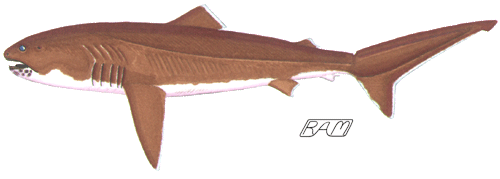Family Megachasmidae:
Megamouth Shark — 1 species
`
- mouth exceptionally large, terminal
- snout short and broadly rounded
- gill openings moderately long, but not extending onto the top of the head
- teeth small and hooked, in numerous rows
- gill rakers unique: cartilage-cored, finger-like dermal papillae
- precaudal pits present
- second dorsal and anal fins small, both with pivoting bases
- precaudal pits present; tail stalk thick without lateral keels
- upper lobe of caudal fin long (about half the length of the body), lower lobe well developed
- scattered records from deep waters of the Pacific (California, Hawaiian Islands, Japan, and the Philippines), eastern and western Atlantic (Senegal and Brazil), and eastern Indian (Western Australia) oceans

Megamouth Shark (Megachasma pelagios)
In November 1976, a 14.6-foot (4.46-metre), 1,650-pound (750-kilogram) male specimen of a previously unknown species of shark was captured accidentally off Oahu, Hawaii, having partially swallowed a U.S. Navy ship's parachute-like sea anchor. Examined on shore by ichthyologist Leighton R. Taylor, it soon became clear that the huge, rubbery-lipped fish was indeed a shark species, genus and family entirely new to science. Apparently a deep-sea planktivore, the creature was hailed as one of the greatest ichthyological discoveries of the 20th Century. Although the media quickly dubbed the new shark "Megamouth", the creature was not to receive a scientific name for another 6.5 years. Spurred into action by a splendid practical joke conspired by ichthyologist John E. McCosker and artist Richard Ellis, Taylor and his co-authors Leonard Compagno and Paul J. Struhsaker finally published the paper formally describing and naming the Megamouth Shark (Megachasma pelagios) in July 1983. The species is now known from a total of 11 specimens, including two females and two juvenile males.
On first inspection, the Megamouth Shark is so odd, it is easy to see how it warranted its own family. But due to its planktivorous modus vivendi and deep-water habitat, many of Megamouth's features that might be useful for determining its relationship to other lamnoids are modified and degenerate. Megamouth's specializations for filter-feeding include greatly reduced teeth and papillose gill rakers; its adaptations to the cold, nutrient-poor mesopelagic zone include mushy muscles and a poorly-calcified skeleton. In 1985, paleontologist John G. Maisey published a short paper discussing relationships of the Megamouth Shark. Based on similarities in dental, gill-raker, cranial, and other skeletal characters, Maisey concluded that Megamouth was most closely related to the Basking Shark (Cetorhinus maximus), suggesting that Megamouth should be included with it in the family Cetorhinidae. In 1990, Leonard Compagno published a refutation of Maisey's conclusions and proposed a cladogram summarizing interrelationships among all extant lamnoids. According to Compagno's interpretation, the Megamouth Shark is ancestral to the threshers and only distantly related to the Basking Shark. Thus, Megamouth warrants placement in a separate and distinct family, Megachasmidae.
Enter the molecular systematists. The first known female Megamouth (specimen no. 7), was found stranded and moribund in Hakata Bay, Japan. To celebrate the opportunity to study this important specimen, Koji Takada and several of his Japanese colleagues decided to host an international conference on the biology of the Megamouth Shark at the Fukuoka Marine World and publish the results in a symposium volume. In separate papers using slightly different genetic markers, two independant teams of molecular systematists (John F. Morrissey, Katherine A. Dunn, and Francesco Mulé forming one team, Andrew Martin and Gavin Naylor the other) studied the relationships of Megamouth to other lamnoids. Although the cladograms each team presented differ in some details, both concluded that the Megamouth Shark was only distantly related to the basking shark. Naylor et al. (1997) further supports the theory that Megamouth and Basking Sharks represent separate lamnoid lineages. These findings fully support Compagno's contention that Megamouth should be placed in its own family, separate from the Basking Shark. But perhaps most interesting, the genetic findings strongly suggest that filter-feeding had evolved twice, in two separate lineages of lamnoid shark. Many of the similarities between the anatomy of Megamouth and the Basking Shark noted by Maisey are therefore most likely due to similar challenges inherent to a filter feeding mode of life.
Due to its tiny, degenerate teeth, the fossil history of Megamouth is difficult to trace. According to paleoichthyologist David Ward, the oldest known Megachasma specimens are fossilized teeth about 42 million years old. Ward's paleontological work is highly respected and his interpretation in this matter will probably hold up to professional scrutiny. But, as these specimens have not been formally described in the technical literature (it is unpublished material from Ward's personal collection), they are not widely available for examination and debate by other paleontologists. Thus, their identification and estimated age should be considered tentative at present.
More about the life history and behavior of the Megamouth
Shark
Ecology of the Megamouth Shark
